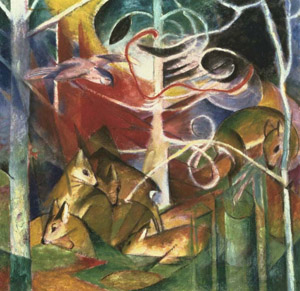
Franz Marc, Deer in the Forest I, 1913. Oil on canvas, 39 3/4 x 41 1/4 in. The Phillips Collection, Washington, DC, Gift from the estate of Katherine S. Dreier, 1953
If you happen to walk through the Music Room, take a look to your right on the way to the staircase. There by the elevator hangs one of my favorite works in The Phillips Collection, Deer in the Forest I (1913). The artist, Franz Marc, combines cubism and symbolism in this painting, creating a dynamic landscape filled with vibrant colors and bold lines. One of the main reasons I love this painting so much (besides the adorable cubist deer!) is because of the symbolic way Marc used color. Franz Marc always used color to tell a story, or to represent a feeling in his works instead of just recreating the physical reality of his subjects. It is known also that Marc assigned certain characteristics to each color that he used. Blue was the color Marc used to represent masculinity and spirituality, yellow he identified as feminine and joyful, and red symbolized either serious undertones or violence. By knowing the symbolism in Franz Marc’s use of color, Deer in the Forest I takes on new meaning. The foreground of the painting is dominated by the yellow deer themselves and the green of their surroundings, evoking a sense of security and contentment. But the red splashed over the background looms above the deer, hinting, perhaps, at the danger and violence that lurks outside of their peaceful forest home.
Read more about this work on our website.
Veronica Parker, Director’s Office Intern

